MG411: Analyzing People Management Issues, Skills & HR Processes
VerifiedAdded on 2023/06/17
|10
|2774
|406
Report
AI Summary
This report provides an overview of people management, focusing on the challenges faced by line management during the pandemic, such as leadership development and employee retention. It suggests using situational leadership and Maslow's hierarchy of needs to address these issues. The report also identifies essential knowledge, skills, and behaviors for effective people managers, including planning and team building, supported by management by objectives and Tuckman's theory. Furthermore, it explores HR processes that underpin performance management, such as training and development, employee relations, and performance management reviews, recommending the use of 360-degree appraisals. The report emphasizes the importance of healthy communication between leaders and employees and continuous growth.
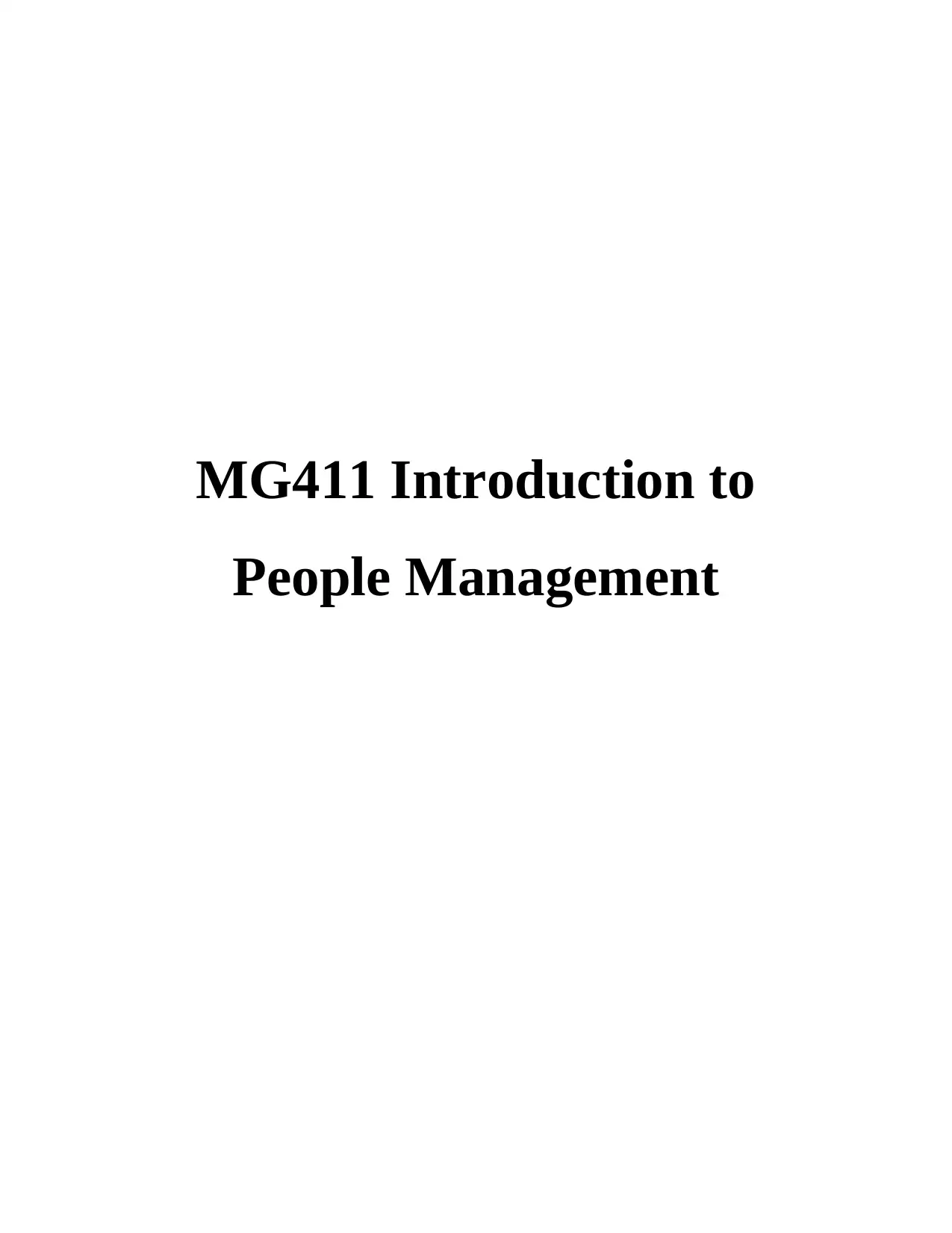
MG411 Introduction to
People Management
People Management
Paraphrase This Document
Need a fresh take? Get an instant paraphrase of this document with our AI Paraphraser
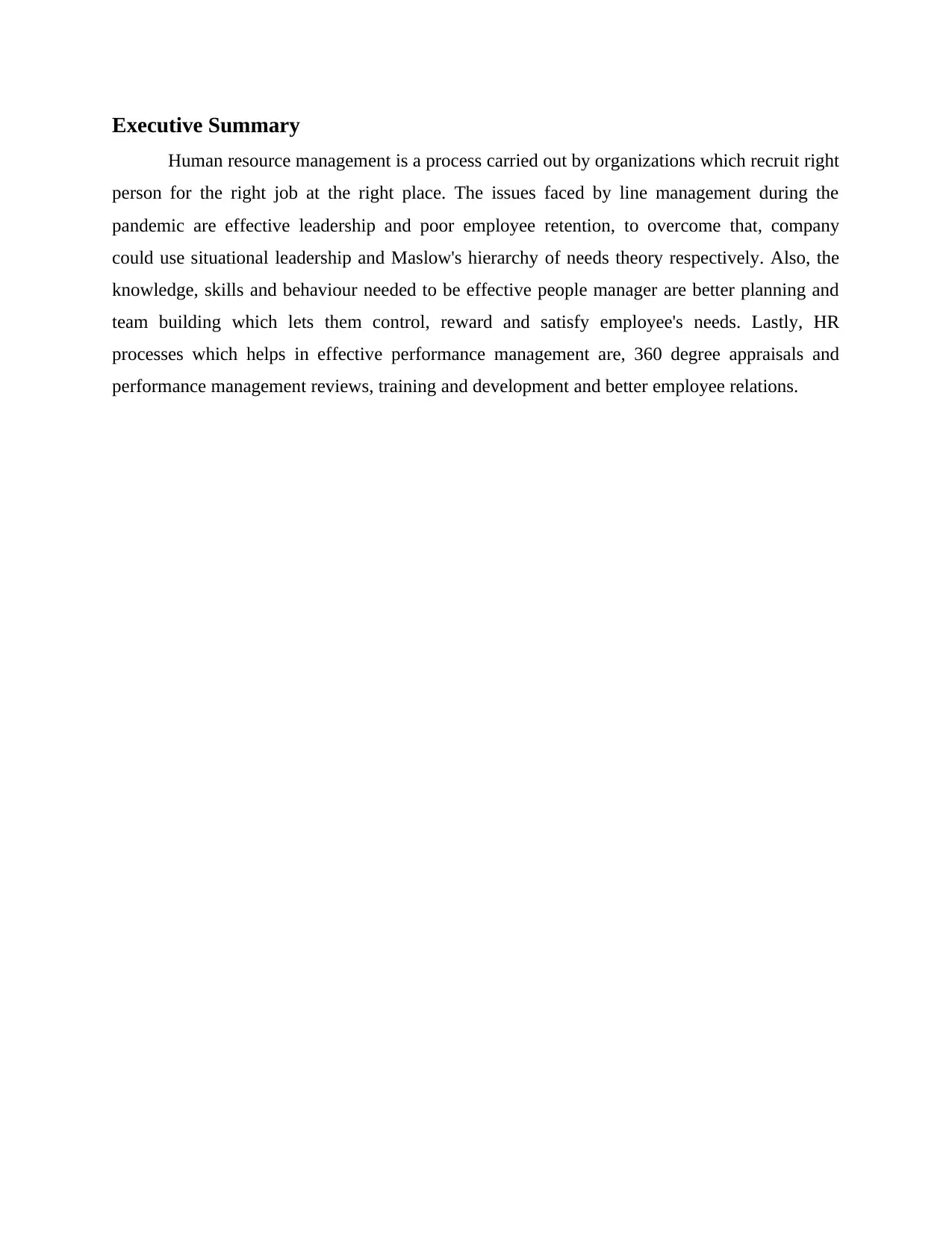
Executive Summary
Human resource management is a process carried out by organizations which recruit right
person for the right job at the right place. The issues faced by line management during the
pandemic are effective leadership and poor employee retention, to overcome that, company
could use situational leadership and Maslow's hierarchy of needs theory respectively. Also, the
knowledge, skills and behaviour needed to be effective people manager are better planning and
team building which lets them control, reward and satisfy employee's needs. Lastly, HR
processes which helps in effective performance management are, 360 degree appraisals and
performance management reviews, training and development and better employee relations.
Human resource management is a process carried out by organizations which recruit right
person for the right job at the right place. The issues faced by line management during the
pandemic are effective leadership and poor employee retention, to overcome that, company
could use situational leadership and Maslow's hierarchy of needs theory respectively. Also, the
knowledge, skills and behaviour needed to be effective people manager are better planning and
team building which lets them control, reward and satisfy employee's needs. Lastly, HR
processes which helps in effective performance management are, 360 degree appraisals and
performance management reviews, training and development and better employee relations.
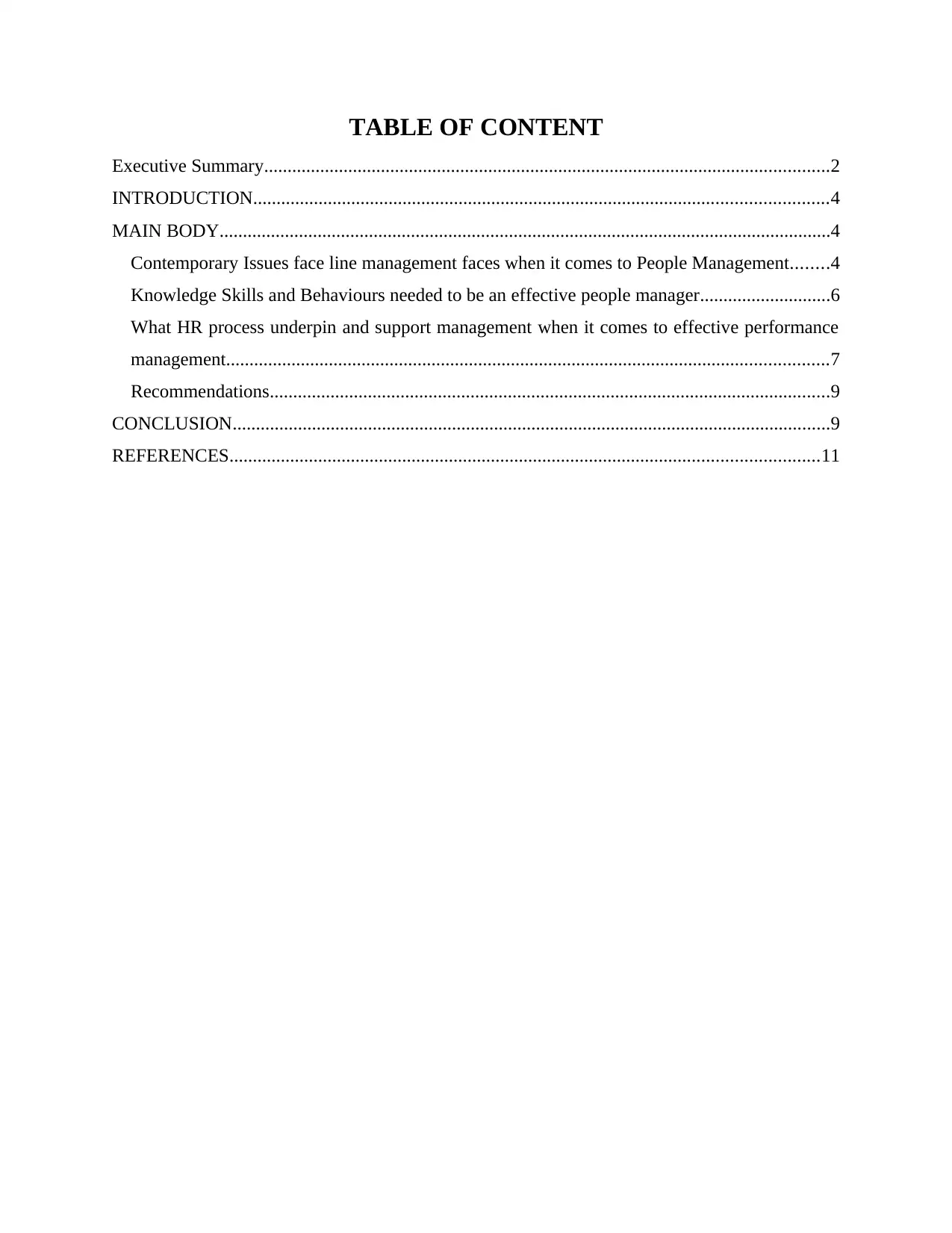
TABLE OF CONTENT
Executive Summary.........................................................................................................................2
INTRODUCTION...........................................................................................................................4
MAIN BODY...................................................................................................................................4
Contemporary Issues face line management faces when it comes to People Management........4
Knowledge Skills and Behaviours needed to be an effective people manager............................6
What HR process underpin and support management when it comes to effective performance
management.................................................................................................................................7
Recommendations........................................................................................................................9
CONCLUSION................................................................................................................................9
REFERENCES..............................................................................................................................11
Executive Summary.........................................................................................................................2
INTRODUCTION...........................................................................................................................4
MAIN BODY...................................................................................................................................4
Contemporary Issues face line management faces when it comes to People Management........4
Knowledge Skills and Behaviours needed to be an effective people manager............................6
What HR process underpin and support management when it comes to effective performance
management.................................................................................................................................7
Recommendations........................................................................................................................9
CONCLUSION................................................................................................................................9
REFERENCES..............................................................................................................................11
⊘ This is a preview!⊘
Do you want full access?
Subscribe today to unlock all pages.

Trusted by 1+ million students worldwide
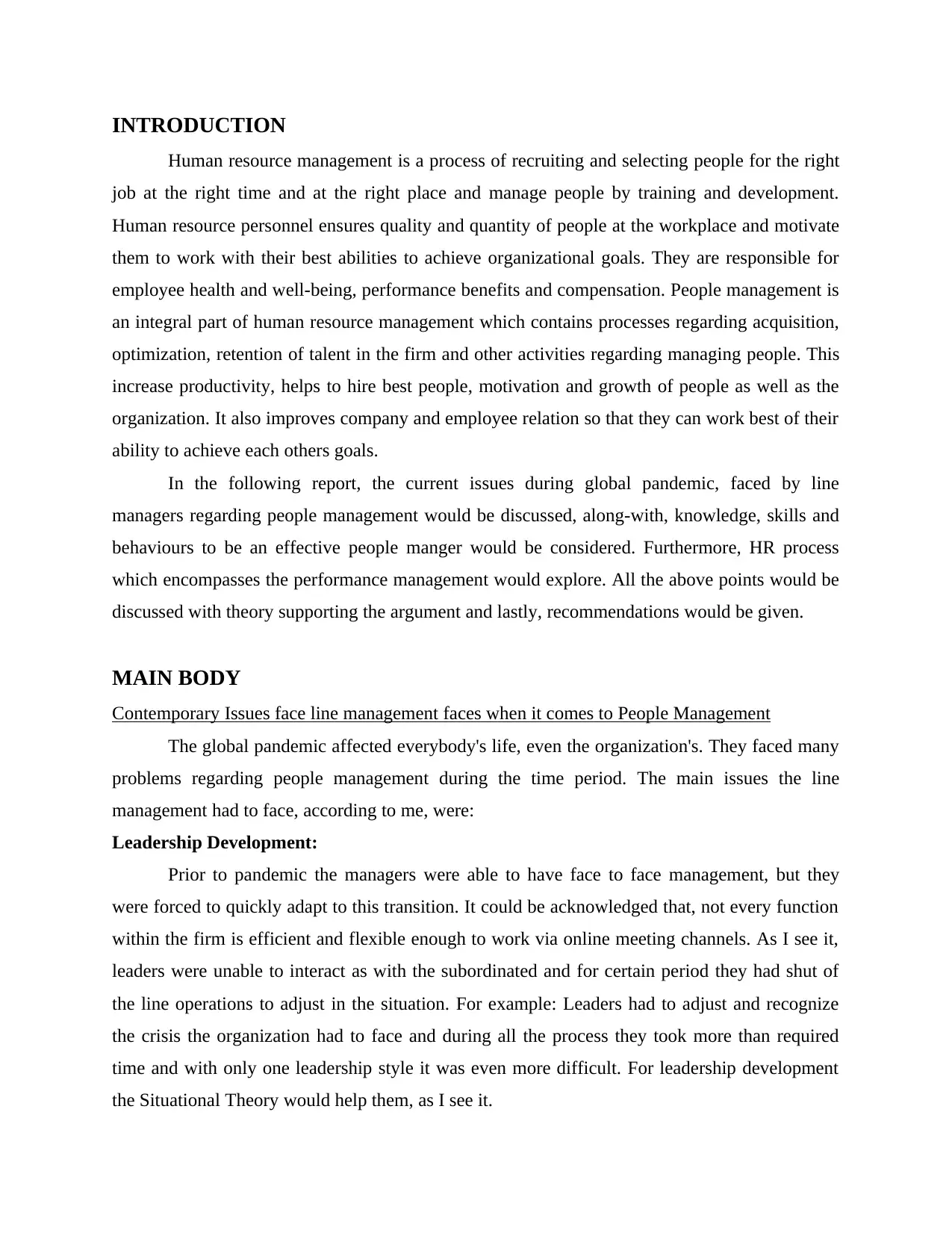
INTRODUCTION
Human resource management is a process of recruiting and selecting people for the right
job at the right time and at the right place and manage people by training and development.
Human resource personnel ensures quality and quantity of people at the workplace and motivate
them to work with their best abilities to achieve organizational goals. They are responsible for
employee health and well-being, performance benefits and compensation. People management is
an integral part of human resource management which contains processes regarding acquisition,
optimization, retention of talent in the firm and other activities regarding managing people. This
increase productivity, helps to hire best people, motivation and growth of people as well as the
organization. It also improves company and employee relation so that they can work best of their
ability to achieve each others goals.
In the following report, the current issues during global pandemic, faced by line
managers regarding people management would be discussed, along-with, knowledge, skills and
behaviours to be an effective people manger would be considered. Furthermore, HR process
which encompasses the performance management would explore. All the above points would be
discussed with theory supporting the argument and lastly, recommendations would be given.
MAIN BODY
Contemporary Issues face line management faces when it comes to People Management
The global pandemic affected everybody's life, even the organization's. They faced many
problems regarding people management during the time period. The main issues the line
management had to face, according to me, were:
Leadership Development:
Prior to pandemic the managers were able to have face to face management, but they
were forced to quickly adapt to this transition. It could be acknowledged that, not every function
within the firm is efficient and flexible enough to work via online meeting channels. As I see it,
leaders were unable to interact as with the subordinated and for certain period they had shut of
the line operations to adjust in the situation. For example: Leaders had to adjust and recognize
the crisis the organization had to face and during all the process they took more than required
time and with only one leadership style it was even more difficult. For leadership development
the Situational Theory would help them, as I see it.
Human resource management is a process of recruiting and selecting people for the right
job at the right time and at the right place and manage people by training and development.
Human resource personnel ensures quality and quantity of people at the workplace and motivate
them to work with their best abilities to achieve organizational goals. They are responsible for
employee health and well-being, performance benefits and compensation. People management is
an integral part of human resource management which contains processes regarding acquisition,
optimization, retention of talent in the firm and other activities regarding managing people. This
increase productivity, helps to hire best people, motivation and growth of people as well as the
organization. It also improves company and employee relation so that they can work best of their
ability to achieve each others goals.
In the following report, the current issues during global pandemic, faced by line
managers regarding people management would be discussed, along-with, knowledge, skills and
behaviours to be an effective people manger would be considered. Furthermore, HR process
which encompasses the performance management would explore. All the above points would be
discussed with theory supporting the argument and lastly, recommendations would be given.
MAIN BODY
Contemporary Issues face line management faces when it comes to People Management
The global pandemic affected everybody's life, even the organization's. They faced many
problems regarding people management during the time period. The main issues the line
management had to face, according to me, were:
Leadership Development:
Prior to pandemic the managers were able to have face to face management, but they
were forced to quickly adapt to this transition. It could be acknowledged that, not every function
within the firm is efficient and flexible enough to work via online meeting channels. As I see it,
leaders were unable to interact as with the subordinated and for certain period they had shut of
the line operations to adjust in the situation. For example: Leaders had to adjust and recognize
the crisis the organization had to face and during all the process they took more than required
time and with only one leadership style it was even more difficult. For leadership development
the Situational Theory would help them, as I see it.
Paraphrase This Document
Need a fresh take? Get an instant paraphrase of this document with our AI Paraphraser
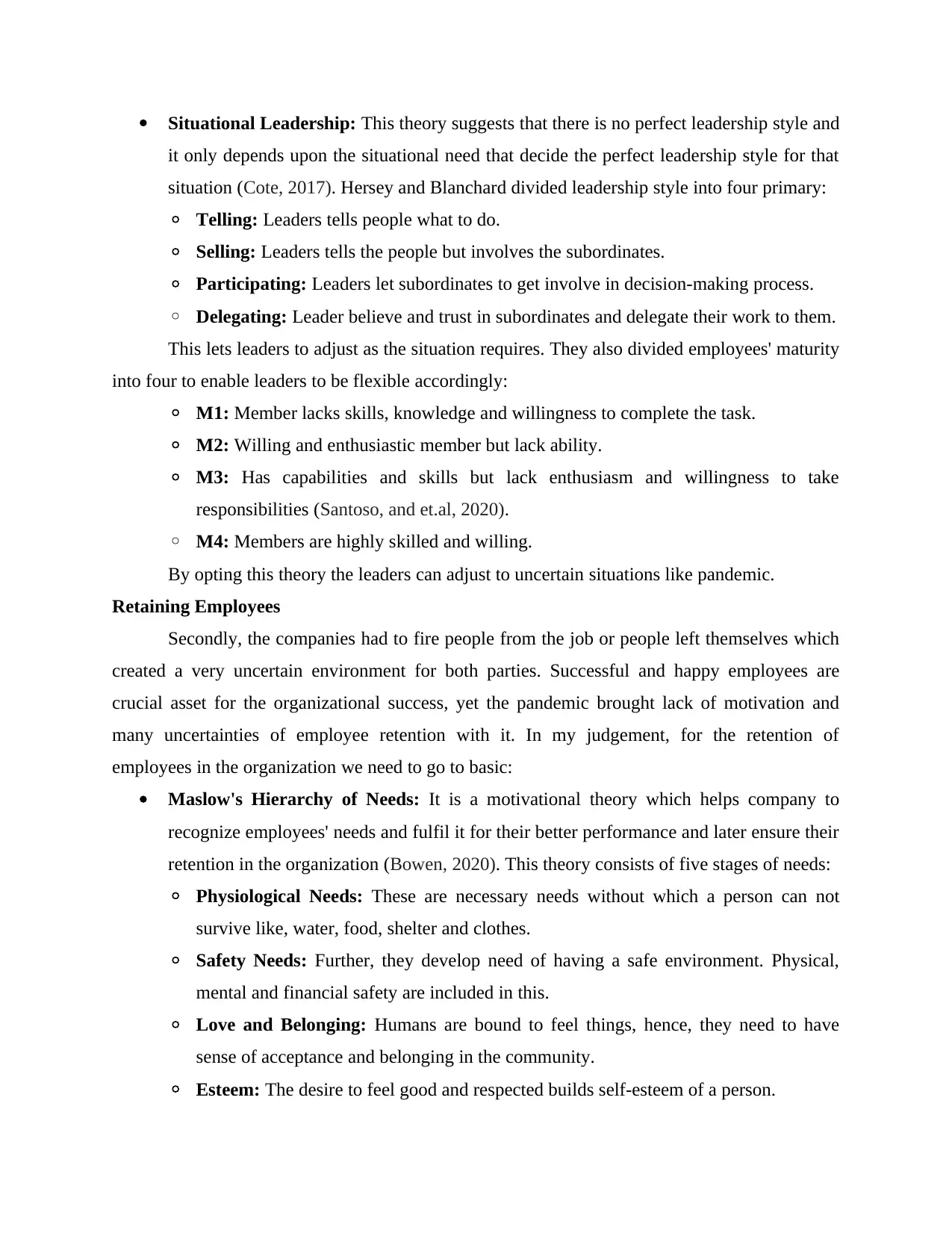
Situational Leadership: This theory suggests that there is no perfect leadership style and
it only depends upon the situational need that decide the perfect leadership style for that
situation (Cote, 2017). Hersey and Blanchard divided leadership style into four primary:
◦ Telling: Leaders tells people what to do.
◦ Selling: Leaders tells the people but involves the subordinates.
◦ Participating: Leaders let subordinates to get involve in decision-making process.
◦ Delegating: Leader believe and trust in subordinates and delegate their work to them.
This lets leaders to adjust as the situation requires. They also divided employees' maturity
into four to enable leaders to be flexible accordingly:
◦ M1: Member lacks skills, knowledge and willingness to complete the task.
◦ M2: Willing and enthusiastic member but lack ability.
◦ M3: Has capabilities and skills but lack enthusiasm and willingness to take
responsibilities (Santoso, and et.al, 2020).
◦ M4: Members are highly skilled and willing.
By opting this theory the leaders can adjust to uncertain situations like pandemic.
Retaining Employees
Secondly, the companies had to fire people from the job or people left themselves which
created a very uncertain environment for both parties. Successful and happy employees are
crucial asset for the organizational success, yet the pandemic brought lack of motivation and
many uncertainties of employee retention with it. In my judgement, for the retention of
employees in the organization we need to go to basic:
Maslow's Hierarchy of Needs: It is a motivational theory which helps company to
recognize employees' needs and fulfil it for their better performance and later ensure their
retention in the organization (Bowen, 2020). This theory consists of five stages of needs:
◦ Physiological Needs: These are necessary needs without which a person can not
survive like, water, food, shelter and clothes.
◦ Safety Needs: Further, they develop need of having a safe environment. Physical,
mental and financial safety are included in this.
◦ Love and Belonging: Humans are bound to feel things, hence, they need to have
sense of acceptance and belonging in the community.
◦ Esteem: The desire to feel good and respected builds self-esteem of a person.
it only depends upon the situational need that decide the perfect leadership style for that
situation (Cote, 2017). Hersey and Blanchard divided leadership style into four primary:
◦ Telling: Leaders tells people what to do.
◦ Selling: Leaders tells the people but involves the subordinates.
◦ Participating: Leaders let subordinates to get involve in decision-making process.
◦ Delegating: Leader believe and trust in subordinates and delegate their work to them.
This lets leaders to adjust as the situation requires. They also divided employees' maturity
into four to enable leaders to be flexible accordingly:
◦ M1: Member lacks skills, knowledge and willingness to complete the task.
◦ M2: Willing and enthusiastic member but lack ability.
◦ M3: Has capabilities and skills but lack enthusiasm and willingness to take
responsibilities (Santoso, and et.al, 2020).
◦ M4: Members are highly skilled and willing.
By opting this theory the leaders can adjust to uncertain situations like pandemic.
Retaining Employees
Secondly, the companies had to fire people from the job or people left themselves which
created a very uncertain environment for both parties. Successful and happy employees are
crucial asset for the organizational success, yet the pandemic brought lack of motivation and
many uncertainties of employee retention with it. In my judgement, for the retention of
employees in the organization we need to go to basic:
Maslow's Hierarchy of Needs: It is a motivational theory which helps company to
recognize employees' needs and fulfil it for their better performance and later ensure their
retention in the organization (Bowen, 2020). This theory consists of five stages of needs:
◦ Physiological Needs: These are necessary needs without which a person can not
survive like, water, food, shelter and clothes.
◦ Safety Needs: Further, they develop need of having a safe environment. Physical,
mental and financial safety are included in this.
◦ Love and Belonging: Humans are bound to feel things, hence, they need to have
sense of acceptance and belonging in the community.
◦ Esteem: The desire to feel good and respected builds self-esteem of a person.
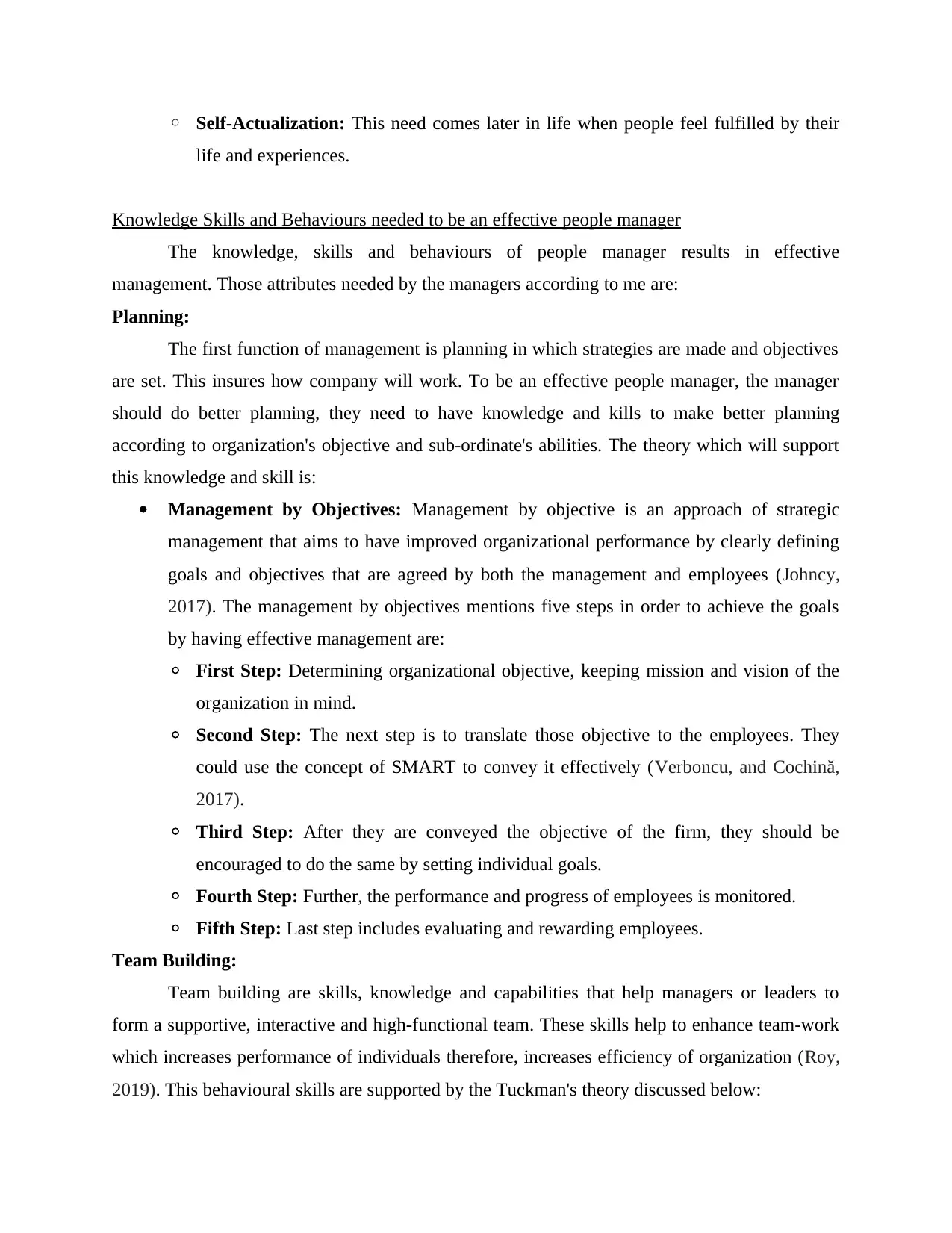
◦ Self-Actualization: This need comes later in life when people feel fulfilled by their
life and experiences.
Knowledge Skills and Behaviours needed to be an effective people manager
The knowledge, skills and behaviours of people manager results in effective
management. Those attributes needed by the managers according to me are:
Planning:
The first function of management is planning in which strategies are made and objectives
are set. This insures how company will work. To be an effective people manager, the manager
should do better planning, they need to have knowledge and kills to make better planning
according to organization's objective and sub-ordinate's abilities. The theory which will support
this knowledge and skill is:
Management by Objectives: Management by objective is an approach of strategic
management that aims to have improved organizational performance by clearly defining
goals and objectives that are agreed by both the management and employees (Johncy,
2017). The management by objectives mentions five steps in order to achieve the goals
by having effective management are:
◦ First Step: Determining organizational objective, keeping mission and vision of the
organization in mind.
◦ Second Step: The next step is to translate those objective to the employees. They
could use the concept of SMART to convey it effectively (Verboncu, and Cochină,
2017).
◦ Third Step: After they are conveyed the objective of the firm, they should be
encouraged to do the same by setting individual goals.
◦ Fourth Step: Further, the performance and progress of employees is monitored.
◦ Fifth Step: Last step includes evaluating and rewarding employees.
Team Building:
Team building are skills, knowledge and capabilities that help managers or leaders to
form a supportive, interactive and high-functional team. These skills help to enhance team-work
which increases performance of individuals therefore, increases efficiency of organization (Roy,
2019). This behavioural skills are supported by the Tuckman's theory discussed below:
life and experiences.
Knowledge Skills and Behaviours needed to be an effective people manager
The knowledge, skills and behaviours of people manager results in effective
management. Those attributes needed by the managers according to me are:
Planning:
The first function of management is planning in which strategies are made and objectives
are set. This insures how company will work. To be an effective people manager, the manager
should do better planning, they need to have knowledge and kills to make better planning
according to organization's objective and sub-ordinate's abilities. The theory which will support
this knowledge and skill is:
Management by Objectives: Management by objective is an approach of strategic
management that aims to have improved organizational performance by clearly defining
goals and objectives that are agreed by both the management and employees (Johncy,
2017). The management by objectives mentions five steps in order to achieve the goals
by having effective management are:
◦ First Step: Determining organizational objective, keeping mission and vision of the
organization in mind.
◦ Second Step: The next step is to translate those objective to the employees. They
could use the concept of SMART to convey it effectively (Verboncu, and Cochină,
2017).
◦ Third Step: After they are conveyed the objective of the firm, they should be
encouraged to do the same by setting individual goals.
◦ Fourth Step: Further, the performance and progress of employees is monitored.
◦ Fifth Step: Last step includes evaluating and rewarding employees.
Team Building:
Team building are skills, knowledge and capabilities that help managers or leaders to
form a supportive, interactive and high-functional team. These skills help to enhance team-work
which increases performance of individuals therefore, increases efficiency of organization (Roy,
2019). This behavioural skills are supported by the Tuckman's theory discussed below:
⊘ This is a preview!⊘
Do you want full access?
Subscribe today to unlock all pages.

Trusted by 1+ million students worldwide
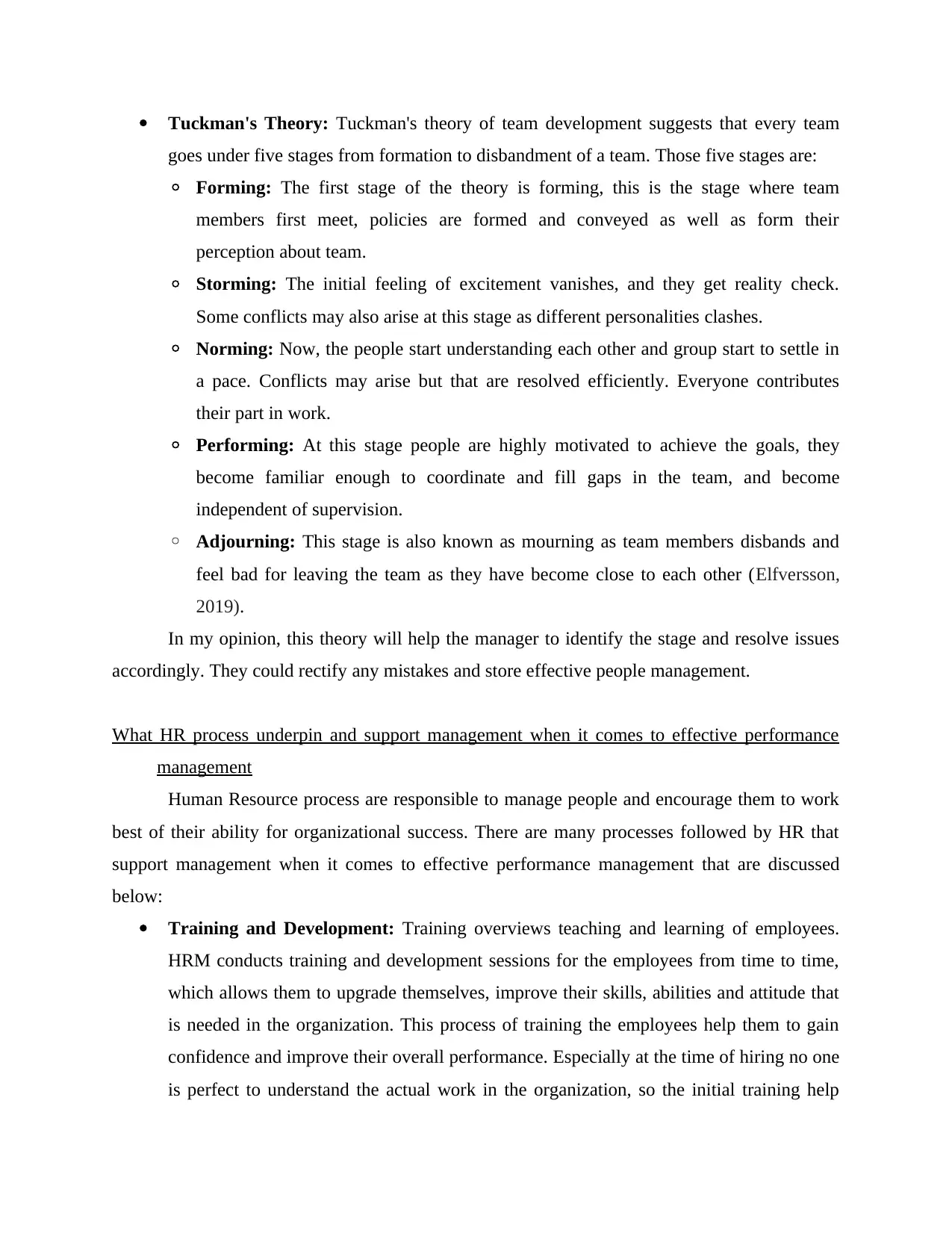
Tuckman's Theory: Tuckman's theory of team development suggests that every team
goes under five stages from formation to disbandment of a team. Those five stages are:
◦ Forming: The first stage of the theory is forming, this is the stage where team
members first meet, policies are formed and conveyed as well as form their
perception about team.
◦ Storming: The initial feeling of excitement vanishes, and they get reality check.
Some conflicts may also arise at this stage as different personalities clashes.
◦ Norming: Now, the people start understanding each other and group start to settle in
a pace. Conflicts may arise but that are resolved efficiently. Everyone contributes
their part in work.
◦ Performing: At this stage people are highly motivated to achieve the goals, they
become familiar enough to coordinate and fill gaps in the team, and become
independent of supervision.
◦ Adjourning: This stage is also known as mourning as team members disbands and
feel bad for leaving the team as they have become close to each other (Elfversson,
2019).
In my opinion, this theory will help the manager to identify the stage and resolve issues
accordingly. They could rectify any mistakes and store effective people management.
What HR process underpin and support management when it comes to effective performance
management
Human Resource process are responsible to manage people and encourage them to work
best of their ability for organizational success. There are many processes followed by HR that
support management when it comes to effective performance management that are discussed
below:
Training and Development: Training overviews teaching and learning of employees.
HRM conducts training and development sessions for the employees from time to time,
which allows them to upgrade themselves, improve their skills, abilities and attitude that
is needed in the organization. This process of training the employees help them to gain
confidence and improve their overall performance. Especially at the time of hiring no one
is perfect to understand the actual work in the organization, so the initial training help
goes under five stages from formation to disbandment of a team. Those five stages are:
◦ Forming: The first stage of the theory is forming, this is the stage where team
members first meet, policies are formed and conveyed as well as form their
perception about team.
◦ Storming: The initial feeling of excitement vanishes, and they get reality check.
Some conflicts may also arise at this stage as different personalities clashes.
◦ Norming: Now, the people start understanding each other and group start to settle in
a pace. Conflicts may arise but that are resolved efficiently. Everyone contributes
their part in work.
◦ Performing: At this stage people are highly motivated to achieve the goals, they
become familiar enough to coordinate and fill gaps in the team, and become
independent of supervision.
◦ Adjourning: This stage is also known as mourning as team members disbands and
feel bad for leaving the team as they have become close to each other (Elfversson,
2019).
In my opinion, this theory will help the manager to identify the stage and resolve issues
accordingly. They could rectify any mistakes and store effective people management.
What HR process underpin and support management when it comes to effective performance
management
Human Resource process are responsible to manage people and encourage them to work
best of their ability for organizational success. There are many processes followed by HR that
support management when it comes to effective performance management that are discussed
below:
Training and Development: Training overviews teaching and learning of employees.
HRM conducts training and development sessions for the employees from time to time,
which allows them to upgrade themselves, improve their skills, abilities and attitude that
is needed in the organization. This process of training the employees help them to gain
confidence and improve their overall performance. Especially at the time of hiring no one
is perfect to understand the actual work in the organization, so the initial training help
Paraphrase This Document
Need a fresh take? Get an instant paraphrase of this document with our AI Paraphraser
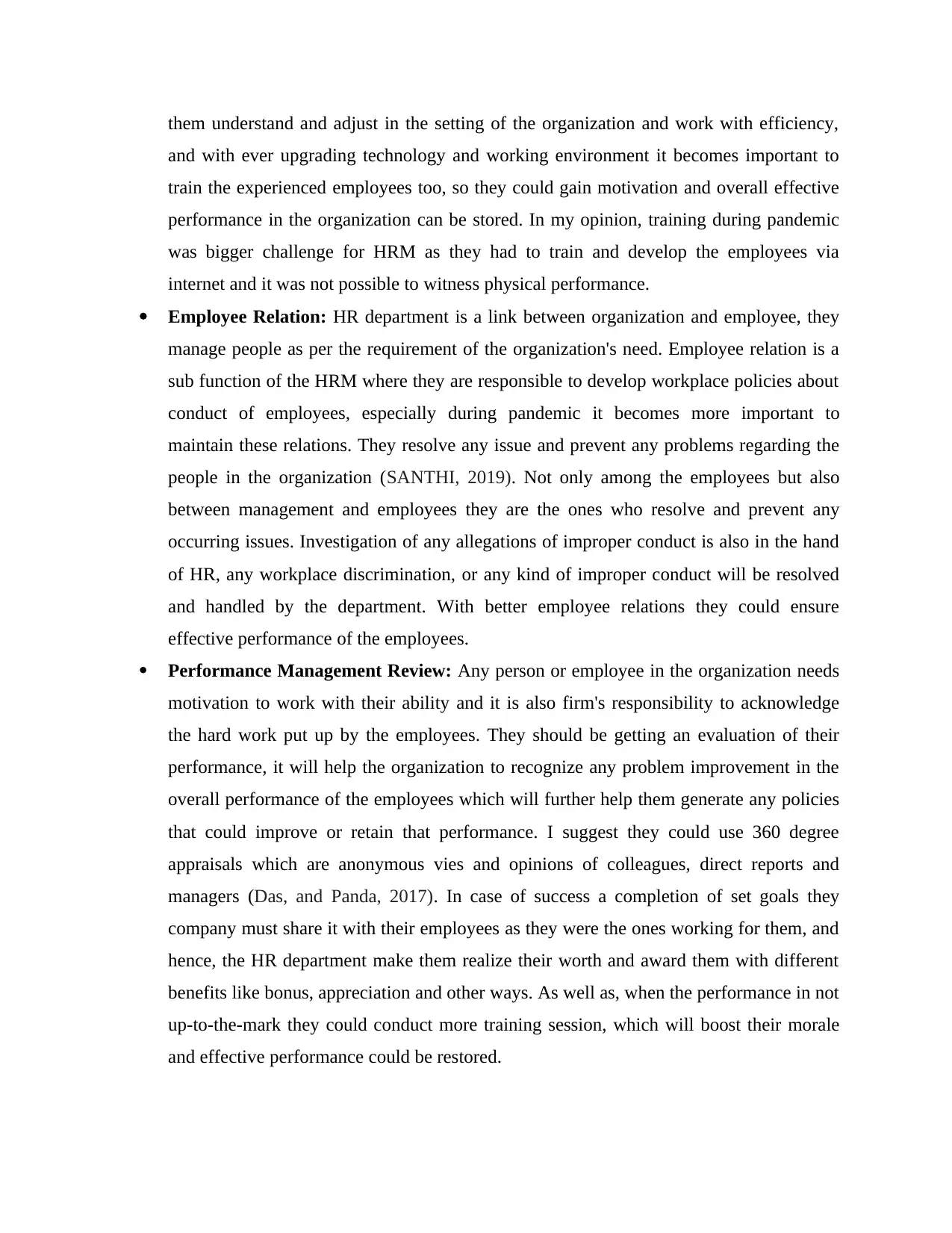
them understand and adjust in the setting of the organization and work with efficiency,
and with ever upgrading technology and working environment it becomes important to
train the experienced employees too, so they could gain motivation and overall effective
performance in the organization can be stored. In my opinion, training during pandemic
was bigger challenge for HRM as they had to train and develop the employees via
internet and it was not possible to witness physical performance.
Employee Relation: HR department is a link between organization and employee, they
manage people as per the requirement of the organization's need. Employee relation is a
sub function of the HRM where they are responsible to develop workplace policies about
conduct of employees, especially during pandemic it becomes more important to
maintain these relations. They resolve any issue and prevent any problems regarding the
people in the organization (SANTHI, 2019). Not only among the employees but also
between management and employees they are the ones who resolve and prevent any
occurring issues. Investigation of any allegations of improper conduct is also in the hand
of HR, any workplace discrimination, or any kind of improper conduct will be resolved
and handled by the department. With better employee relations they could ensure
effective performance of the employees.
Performance Management Review: Any person or employee in the organization needs
motivation to work with their ability and it is also firm's responsibility to acknowledge
the hard work put up by the employees. They should be getting an evaluation of their
performance, it will help the organization to recognize any problem improvement in the
overall performance of the employees which will further help them generate any policies
that could improve or retain that performance. I suggest they could use 360 degree
appraisals which are anonymous vies and opinions of colleagues, direct reports and
managers (Das, and Panda, 2017). In case of success a completion of set goals they
company must share it with their employees as they were the ones working for them, and
hence, the HR department make them realize their worth and award them with different
benefits like bonus, appreciation and other ways. As well as, when the performance in not
up-to-the-mark they could conduct more training session, which will boost their morale
and effective performance could be restored.
and with ever upgrading technology and working environment it becomes important to
train the experienced employees too, so they could gain motivation and overall effective
performance in the organization can be stored. In my opinion, training during pandemic
was bigger challenge for HRM as they had to train and develop the employees via
internet and it was not possible to witness physical performance.
Employee Relation: HR department is a link between organization and employee, they
manage people as per the requirement of the organization's need. Employee relation is a
sub function of the HRM where they are responsible to develop workplace policies about
conduct of employees, especially during pandemic it becomes more important to
maintain these relations. They resolve any issue and prevent any problems regarding the
people in the organization (SANTHI, 2019). Not only among the employees but also
between management and employees they are the ones who resolve and prevent any
occurring issues. Investigation of any allegations of improper conduct is also in the hand
of HR, any workplace discrimination, or any kind of improper conduct will be resolved
and handled by the department. With better employee relations they could ensure
effective performance of the employees.
Performance Management Review: Any person or employee in the organization needs
motivation to work with their ability and it is also firm's responsibility to acknowledge
the hard work put up by the employees. They should be getting an evaluation of their
performance, it will help the organization to recognize any problem improvement in the
overall performance of the employees which will further help them generate any policies
that could improve or retain that performance. I suggest they could use 360 degree
appraisals which are anonymous vies and opinions of colleagues, direct reports and
managers (Das, and Panda, 2017). In case of success a completion of set goals they
company must share it with their employees as they were the ones working for them, and
hence, the HR department make them realize their worth and award them with different
benefits like bonus, appreciation and other ways. As well as, when the performance in not
up-to-the-mark they could conduct more training session, which will boost their morale
and effective performance could be restored.
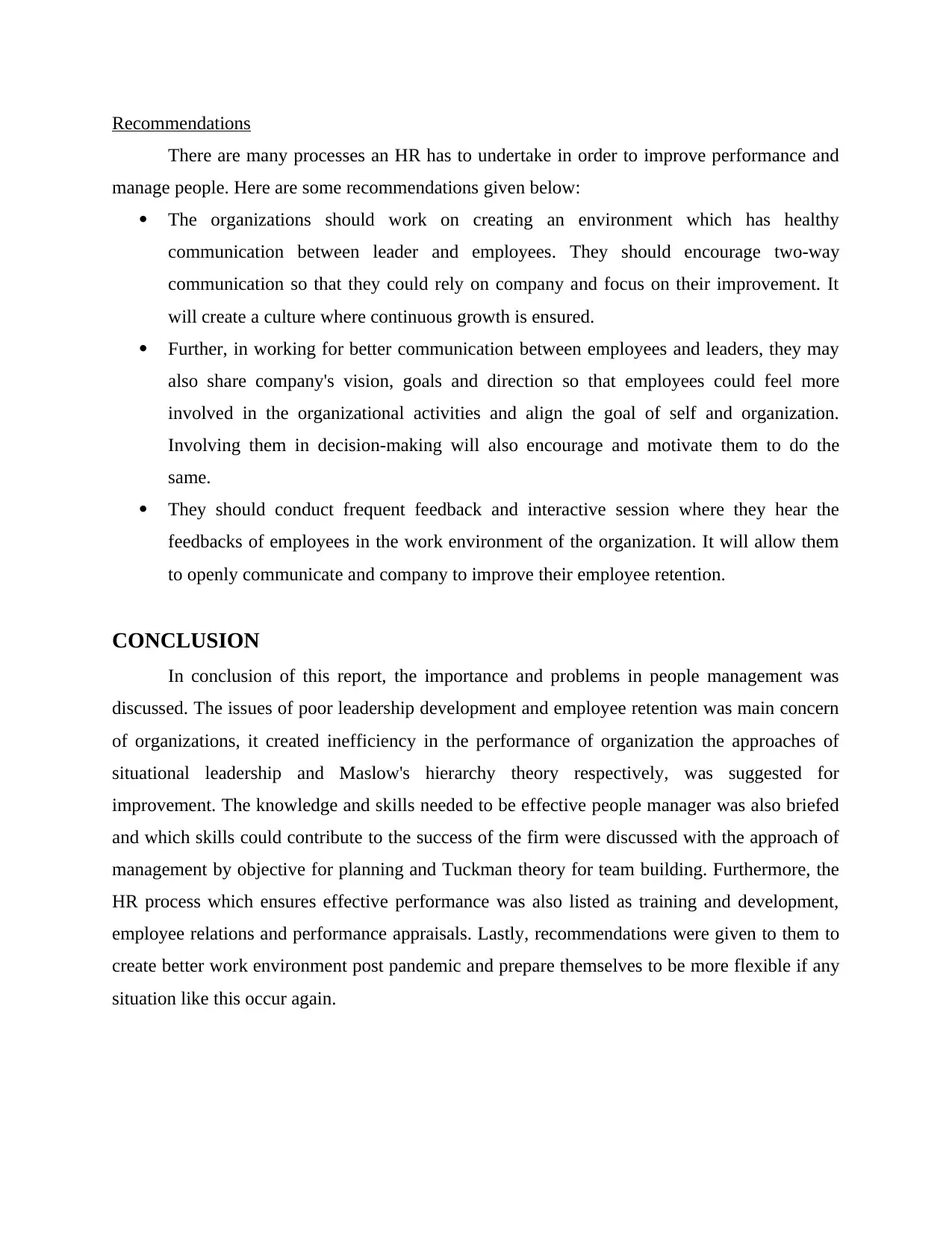
Recommendations
There are many processes an HR has to undertake in order to improve performance and
manage people. Here are some recommendations given below:
The organizations should work on creating an environment which has healthy
communication between leader and employees. They should encourage two-way
communication so that they could rely on company and focus on their improvement. It
will create a culture where continuous growth is ensured.
Further, in working for better communication between employees and leaders, they may
also share company's vision, goals and direction so that employees could feel more
involved in the organizational activities and align the goal of self and organization.
Involving them in decision-making will also encourage and motivate them to do the
same.
They should conduct frequent feedback and interactive session where they hear the
feedbacks of employees in the work environment of the organization. It will allow them
to openly communicate and company to improve their employee retention.
CONCLUSION
In conclusion of this report, the importance and problems in people management was
discussed. The issues of poor leadership development and employee retention was main concern
of organizations, it created inefficiency in the performance of organization the approaches of
situational leadership and Maslow's hierarchy theory respectively, was suggested for
improvement. The knowledge and skills needed to be effective people manager was also briefed
and which skills could contribute to the success of the firm were discussed with the approach of
management by objective for planning and Tuckman theory for team building. Furthermore, the
HR process which ensures effective performance was also listed as training and development,
employee relations and performance appraisals. Lastly, recommendations were given to them to
create better work environment post pandemic and prepare themselves to be more flexible if any
situation like this occur again.
There are many processes an HR has to undertake in order to improve performance and
manage people. Here are some recommendations given below:
The organizations should work on creating an environment which has healthy
communication between leader and employees. They should encourage two-way
communication so that they could rely on company and focus on their improvement. It
will create a culture where continuous growth is ensured.
Further, in working for better communication between employees and leaders, they may
also share company's vision, goals and direction so that employees could feel more
involved in the organizational activities and align the goal of self and organization.
Involving them in decision-making will also encourage and motivate them to do the
same.
They should conduct frequent feedback and interactive session where they hear the
feedbacks of employees in the work environment of the organization. It will allow them
to openly communicate and company to improve their employee retention.
CONCLUSION
In conclusion of this report, the importance and problems in people management was
discussed. The issues of poor leadership development and employee retention was main concern
of organizations, it created inefficiency in the performance of organization the approaches of
situational leadership and Maslow's hierarchy theory respectively, was suggested for
improvement. The knowledge and skills needed to be effective people manager was also briefed
and which skills could contribute to the success of the firm were discussed with the approach of
management by objective for planning and Tuckman theory for team building. Furthermore, the
HR process which ensures effective performance was also listed as training and development,
employee relations and performance appraisals. Lastly, recommendations were given to them to
create better work environment post pandemic and prepare themselves to be more flexible if any
situation like this occur again.
⊘ This is a preview!⊘
Do you want full access?
Subscribe today to unlock all pages.

Trusted by 1+ million students worldwide
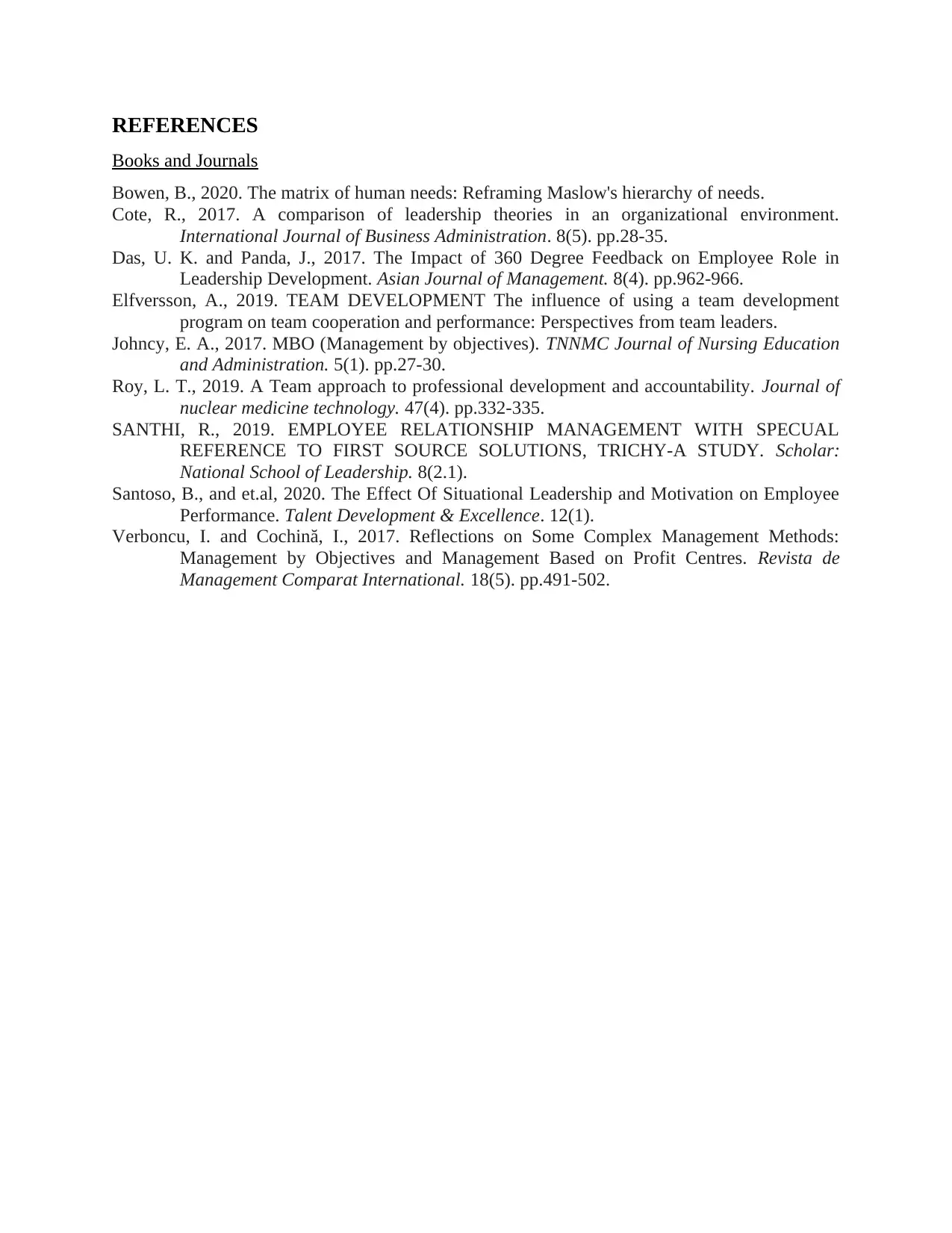
REFERENCES
Books and Journals
Bowen, B., 2020. The matrix of human needs: Reframing Maslow's hierarchy of needs.
Cote, R., 2017. A comparison of leadership theories in an organizational environment.
International Journal of Business Administration. 8(5). pp.28-35.
Das, U. K. and Panda, J., 2017. The Impact of 360 Degree Feedback on Employee Role in
Leadership Development. Asian Journal of Management. 8(4). pp.962-966.
Elfversson, A., 2019. TEAM DEVELOPMENT The influence of using a team development
program on team cooperation and performance: Perspectives from team leaders.
Johncy, E. A., 2017. MBO (Management by objectives). TNNMC Journal of Nursing Education
and Administration. 5(1). pp.27-30.
Roy, L. T., 2019. A Team approach to professional development and accountability. Journal of
nuclear medicine technology. 47(4). pp.332-335.
SANTHI, R., 2019. EMPLOYEE RELATIONSHIP MANAGEMENT WITH SPECUAL
REFERENCE TO FIRST SOURCE SOLUTIONS, TRICHY-A STUDY. Scholar:
National School of Leadership. 8(2.1).
Santoso, B., and et.al, 2020. The Effect Of Situational Leadership and Motivation on Employee
Performance. Talent Development & Excellence. 12(1).
Verboncu, I. and Cochină, I., 2017. Reflections on Some Complex Management Methods:
Management by Objectives and Management Based on Profit Centres. Revista de
Management Comparat International. 18(5). pp.491-502.
Books and Journals
Bowen, B., 2020. The matrix of human needs: Reframing Maslow's hierarchy of needs.
Cote, R., 2017. A comparison of leadership theories in an organizational environment.
International Journal of Business Administration. 8(5). pp.28-35.
Das, U. K. and Panda, J., 2017. The Impact of 360 Degree Feedback on Employee Role in
Leadership Development. Asian Journal of Management. 8(4). pp.962-966.
Elfversson, A., 2019. TEAM DEVELOPMENT The influence of using a team development
program on team cooperation and performance: Perspectives from team leaders.
Johncy, E. A., 2017. MBO (Management by objectives). TNNMC Journal of Nursing Education
and Administration. 5(1). pp.27-30.
Roy, L. T., 2019. A Team approach to professional development and accountability. Journal of
nuclear medicine technology. 47(4). pp.332-335.
SANTHI, R., 2019. EMPLOYEE RELATIONSHIP MANAGEMENT WITH SPECUAL
REFERENCE TO FIRST SOURCE SOLUTIONS, TRICHY-A STUDY. Scholar:
National School of Leadership. 8(2.1).
Santoso, B., and et.al, 2020. The Effect Of Situational Leadership and Motivation on Employee
Performance. Talent Development & Excellence. 12(1).
Verboncu, I. and Cochină, I., 2017. Reflections on Some Complex Management Methods:
Management by Objectives and Management Based on Profit Centres. Revista de
Management Comparat International. 18(5). pp.491-502.
1 out of 10
Related Documents
Your All-in-One AI-Powered Toolkit for Academic Success.
+13062052269
info@desklib.com
Available 24*7 on WhatsApp / Email
![[object Object]](/_next/static/media/star-bottom.7253800d.svg)
Unlock your academic potential
Copyright © 2020–2025 A2Z Services. All Rights Reserved. Developed and managed by ZUCOL.




